The N-end rule pathway is mediated by a complex of the RING-type Ubr1 and HECT-type Ufd4 ubiquitin ligases
- PMID: 21076411
- PMCID: PMC3003441
- DOI: 10.1038/ncb2121
The N-end rule pathway is mediated by a complex of the RING-type Ubr1 and HECT-type Ufd4 ubiquitin ligases
Abstract
Substrates of the N-end rule pathway are recognized by the Ubr1 E3 ubiquitin ligase through their destabilizing amino-terminal residues. Our previous work showed that the Ubr1 E3 and the Ufd4 E3 together target an internal degradation signal (degron) of the Mgt1 DNA repair protein. Ufd4 is an E3 enzyme of the ubiquitin-fusion degradation (UFD) pathway that recognizes an N-terminal ubiquitin moiety. Here we show that the RING-type Ubr1 E3 and the HECT-type Ufd4 E3 interact, both physically and functionally. Although Ubr1 can recognize and polyubiquitylate an N-end rule substrate in the absence of Ufd4, the Ubr1-Ufd4 complex is more processive in that it produces a longer substrate-linked polyubiquitin chain. Conversely, Ubr1 can function as a polyubiquitylation-enhancing component of the Ubr1-Ufd4 complex in its targeting of UFD substrates. We also found that Ubr1 can recognize the N-terminal ubiquitin moiety. These and related advances unify two proteolytic systems that have been studied separately for two decades.
Conflict of interest statement
The authors declare that they have no competing financial interest.
Figures
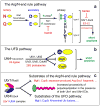

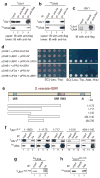
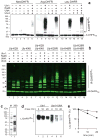
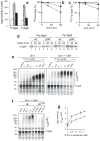
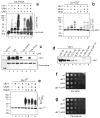
Comment in
-
Working on a chain: E3s ganging up for ubiquitylation.Nat Cell Biol. 2010 Dec;12(12):1124-6. doi: 10.1038/ncb1210-1124. Nat Cell Biol. 2010. PMID: 21124306
-
Ubiquitylation: E3 ligases team up.Nat Rev Mol Cell Biol. 2011 Jan;12(1):6. doi: 10.1038/nrm3033. Epub 2010 Dec 8. Nat Rev Mol Cell Biol. 2011. PMID: 21139637 No abstract available.
Similar articles
-
Five enzymes of the Arg/N-degron pathway form a targeting complex: The concept of superchanneling.Proc Natl Acad Sci U S A. 2020 May 19;117(20):10778-10788. doi: 10.1073/pnas.2003043117. Epub 2020 May 4. Proc Natl Acad Sci U S A. 2020. PMID: 32366662 Free PMC article.
-
Structural visualization of HECT-type E3 ligase Ufd4 accepting and transferring ubiquitin to form K29/K48-branched polyubiquitination.Nat Commun. 2025 May 9;16(1):4313. doi: 10.1038/s41467-025-59569-6. Nat Commun. 2025. PMID: 40341121 Free PMC article.
-
Substrate-binding sites of UBR1, the ubiquitin ligase of the N-end rule pathway.J Biol Chem. 2008 Aug 29;283(35):24011-28. doi: 10.1074/jbc.M802583200. Epub 2008 Jun 19. J Biol Chem. 2008. PMID: 18566452 Free PMC article.
-
Ubiquitin E3 ligases in the plant Arg/N-degron pathway.Biochem J. 2024 Dec 18;481(24):1949-1965. doi: 10.1042/BCJ20240132. Biochem J. 2024. PMID: 39670824 Free PMC article. Review.
-
Proteolytic regulation of metabolic enzymes by E3 ubiquitin ligase complexes: lessons from yeast.Crit Rev Biochem Mol Biol. 2015;50(6):489-502. doi: 10.3109/10409238.2015.1081869. Epub 2015 Sep 11. Crit Rev Biochem Mol Biol. 2015. PMID: 26362128 Review.
Cited by
-
Ubr1-mediated ubiquitylation orchestrates asexual development, polar growth, and virulence-related cellular events in Beauveria bassiana.Appl Microbiol Biotechnol. 2021 Apr;105(7):2747-2758. doi: 10.1007/s00253-021-11222-0. Epub 2021 Mar 8. Appl Microbiol Biotechnol. 2021. PMID: 33686455
-
Proteasome-associated HECT-type ubiquitin ligase activity is required for plant immunity.PLoS Pathog. 2018 Nov 20;14(11):e1007447. doi: 10.1371/journal.ppat.1007447. eCollection 2018 Nov. PLoS Pathog. 2018. PMID: 30458055 Free PMC article.
-
The evolutionarily conserved arginyltransferase 1 mediates a pVHL-independent oxygen-sensing pathway in mammalian cells.Dev Cell. 2022 Mar 14;57(5):654-669.e9. doi: 10.1016/j.devcel.2022.02.010. Epub 2022 Mar 4. Dev Cell. 2022. PMID: 35247316 Free PMC article.
-
Calpain-generated natural protein fragments as short-lived substrates of the N-end rule pathway.Proc Natl Acad Sci U S A. 2014 Mar 4;111(9):E817-26. doi: 10.1073/pnas.1401639111. Epub 2014 Feb 18. Proc Natl Acad Sci U S A. 2014. PMID: 24550490 Free PMC article.
-
E3 Ubiquitin Ligase TRIP12: Regulation, Structure, and Physiopathological Functions.Int J Mol Sci. 2020 Nov 12;21(22):8515. doi: 10.3390/ijms21228515. Int J Mol Sci. 2020. PMID: 33198194 Free PMC article. Review.
References
-
- Bachmair A, Finley D, Varshavsky A. In vivo half-life of a protein is a function of its amino-terminal residue. Science. 1986;234:179–186. - PubMed
-
- Turner GC, Du F, Varshavsky A. Peptides accelerate their uptake by activating a ubiquitin-dependent proteolytic pathway. Nature. 2000;405:579–583. - PubMed
Publication types
MeSH terms
Substances
Grants and funding
LinkOut - more resources
Full Text Sources
Other Literature Sources
Molecular Biology Databases

